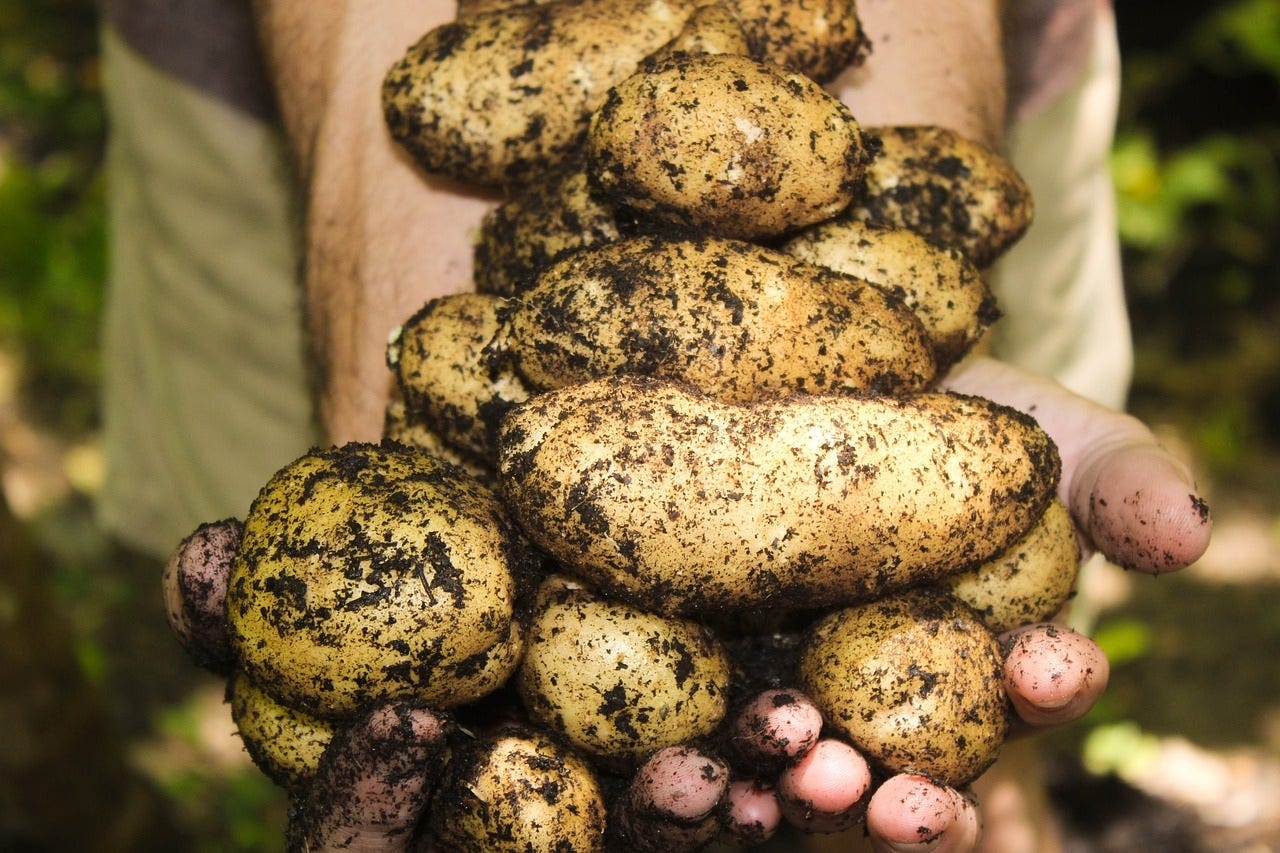Soil 101: Building Rich, Productive Soil for a Thriving Garden
Feed the life within the soil to create a bountiful homestead garden
It’s time to get down and dirty with a deep dive into the basics of soil!
Soil is the very foundation of the garden. Understanding the different elements and organisms at work will help you in building rich and productive soil for a thriving homestead garden. This segment of Farmer Sam’s Growing Gardens will provide you with a basic overview to help you get started.
Welcome to the “The Homesteaders’ Handbook”! If you’re new here, I invite you to check out the Course Entry-Portal to learn what this is. Or view my About Page to find out who I am and why I am doing this. Or just dive right in! At “Runamuk Acres” you’ll find the recantings of one lady-farmer and tree-hugging activist from the western mountains of Maine. #foodieswanted
In This Post:
Soil 101
How Soil Works
Why Soil Life Matters
Identifying Your Soil Type
How to Improve Soil Health
Building Rich and Productive Soil
Bottom-Line
Actionable Tips
Though I am providing this overview on soil, as your friendly neighborhood farmer I strongly encourage newbies to dig deeper into the topic. Impossibly, it wasn’t until 1986 that science established soil as a living ecosystem. Before that, the scientific community regarded the study of microorganisms as a waste of time. Can you believe that?
Certainly, thinking back to the way my grandfather gardened I can see it. Looking at old-school conventional farmers, too, you can see the disconnect evident in the way they over-till and mono-crop the land.
Now that we know better, it’s time to do better.
Soil 101
While the study of soil biology is still relatively young, we’ve learned since the 80’s that it’s the microorganisms which facilitate all of the critically important things happening in soil. Without them we can’t hope to grow healthy plants, let alone thriving gardens.
➡️In honor of World Soil Day, I recently wrote this piece which goes into great detail about the relationship between soil and it’s microorganisms: Beyond Dirt: Transforming Our Mindset to Protect Life and Beneficial Insects.
How Soil Works
According to Dr. Elaine Ingham, the world’s leading soil biologist, all of the nutrients our plants need are already there in the dirt and rocks surrounding their roots, but in an insoluble form.
Plants need the mircoorganisms in the soil to ingest the inorganic nutrients to convert them into a soluble form which they can then extract the necessary nutrients and minerals from.
To encourage this process, plants convert sunlight into “exudates”—essentially a simple sugar—which is stored in and around the plant’s roots. These sugars are used to send a message to bacteria and fungi living in the soil of what the plant requires. Those bacteria and fungi then begin to pull the nutrients from the sand, rocks, clay etc., storing it in their bodies, converting it into an organic form inside the bacteria.
The bacteria and fungi is then eaten by predators: nematodes, protozoa and microarthropods—who then poop out all of the nutrients these microorganisms have stored in their bodies. Thus making the nutrients and minerals available to the plants in an organic form which is easily ingestible for them.
➡️To learn more about the soil food web, I encourage you to watch Dr. Ingham’s video below, or check out the Soil Food Web School for more information.
Why Soil Life Matters
Not only does the soil microbial life help unlock nutrients, making them readily accessible to plants, these organisms offer a broad spectrum of services necessary to any ecosystem:
Soil microorganisms make nutrients available at the rates plants require.
They help plants retain nutrients, preventing soil leaching.
Good bacteria and mircobes protect their host-plants from the bad bacteria and viruses that cause disease.
Soil mircoorganisms suppress weeds by keeping nitrate levels low, while more fungi in the soil means fewer weeds can grow.
Promote carbon sequestration.
They even help to decompose toxins in the soil.
All of this happens because of the biology in our soil. Without soil, all we have is dirt.
Identifying Your Soil Type
If you’re not sure what type of soil you have, there are 3 easy tests you can perform at home and without any special equipment.
SOIL SEDIMENTATION TEST
The soil sedimentation test—or the “jar test”—requires just a tall empty jar, some water and a marker. You’ll simply fill 1/3 of the jar with the soil from your garden plot, then add water to about 1-inch below the rim. Place a lid on the jar, then shake vigorously to mix the soil and the water. Place the jar on a level surface and use the marker to mark the level of the soil sediment after 1-2 minutes, 1 hour and 24 hours.
➡️Check out this pdf-guide from the University of California’s Division of Agriculture and Natural Resources to help you with this.
THE RIBBONING TECHNIQUE
A quick and easy test you can do while out in the field and without any equipment, the ribboning technique allows you to estimate soil texture by hand. You would take a small handful of soil and add enough water to be able to squeeze it into a ball. Feel the ball with your fingers: is it gritty (sand), silky (silt) or plastic/sticky (clay)?
Gently press the ball of soil over the forefinger with your thumb to extrude it in length to form a hanging ribbon. If you can make a short ribbon, soil texture is loamy, a mixture of sand and clay. The longer the ribbon, the more clay is in the soil. If you can’t make a ball, the soil is very sandy.
➡️For more on soil and these at-home soil tests, check out “Three Simple Soil Tests to Determine What Type of Soil You Have” from Deep Green Permaculture.
How to Improve Soil Health
As you establish your first (or tenth) homestead garden plot, you’ll want to either improve or maintain the health of your soil over time. Use these strategies to cultivate a thriving garden:
Avoid Tilling: Protect soil structure and microbial life by practicing no-till or reduced tillage. Farmer Sam’s advice? Invest in silage tarps and a broadfork to employ smothering tactics and aerate soil.
Add Organic Matter: Every spring and fall you should be adding organic matter to your garden beds. This can be anything from compost or aged manure, to leaf-mulch, wood chips, seaweed, etc. Think of it as feeding the soil—or more specifically, the mircoorganisms living therein.
Use Cover Crops: Green manures are another way we can feed our soils. By planting crops of field peas, oats or rye, we can chop the crop at peak maturity to either work it into the soil or plant directly through it as mulch.
➡️ over at The Naturalized Human has written a great resource you should check out for more details on building soil health:
Building Rich and Productive Soil
Now that you have a better understanding of how soil works, you’re ready begin building rich and productive soil for your very own garden. This is the foundation for everything yet to come and it’s worth taking the time to really get to know the soil you’ll be working with.
➡️In our next Growing Gardens segment, we’ll look at methods for establishing new garden beds and how to put this information into action.
The Bottom-Line
Plants need the mircoorganisms in the soil to ingest the inorganic nutrients and convert them into a soluble form which they can then extract the necessary nutrients and minerals from. Feed the life within the soil to create a bountiful homestead garden.
Actionable Tips:
Take a sample from your intended garden site and perform the jar test to analyze your soil’s composition.
Study soil with Dr. Ingham at the Soil Food Web School or watch their videos at YouTube to learn more.
Thanks for reading! I hope this essay helps you along your homesteading journey. If you have any thoughts or questions, feel free to drop a comment below!
Sending love and good juju to you and yours.









I found that moving from Arkansas to Georgia you have different soils to content with along with different weather conditions. It has taken me years to figure it out and I learn something new every growing season.